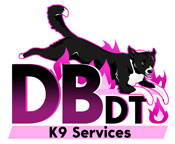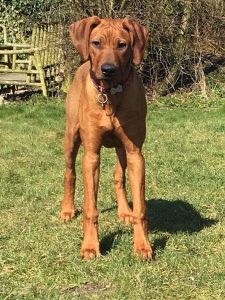 Starting the learn to earn journey with 4-month-old Red
Starting the learn to earn journey with 4-month-old Red
Jayne came out to us when Red was 4 months old. We wanted to lay down good foundations and start on the right track rather than go wrong and have to correct unwanted behaviour later. We were already seeing some behaviours creeping in. Red was starting to ignore recall in the garden, was jumping up at kitchen counters relentlessly, raiding the bins and really pestering and bullying our 10-year-old Ridgeback boy. Basically pushing boundaries.
Jayne spent time explaining the philosophy of the learn to earn approach and demonstrated how to apply it with Red. Essentially no more food in bowls, she would have all her food from our hands but would have to earn each piece of kibble through training or good behaviour. She needed to respond to any given command within 2 seconds of being asked once. We could also give a piece of kibble to reward/reinforce good or wanted behaviour. Jayne showed us how to teach impulse control with a handful of kibble, only giving it to Red a piece at a time, once she stopped trying to get it and looked away or moved back. She also introduced us to ‘The Shaker’ and sensitised Red to it.
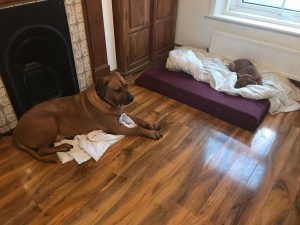
The following morning our journey began! We were to begin by working in the house and once we could get the desired behavioural responses inside, we could then move to the garden. We were to stop walking her both on and off lead out, to prevent rehearsing the wrong behaviour. Only once we had the desired response in the right time frame could we progress from the garden to lead walks.
To begin with, Red did her best to let us know that she really wasn’t bothered. She wouldn’t sit or lie down on command and didn’t get fed that much. On day 2 her behaviour changed. She was around my legs when I prepared my other dog’s bowl. She wasn’t quite so nonchalant about not getting a bowl herself. She kept following me about and would sit randomly and look at me. She began to respond and do some sits and lie-downs… but would get up and walk off as we were reinforcing and rewarding around her. When doing the impulse control she’d do it nicely, take a few bits of kibble then walk off, essentially taking control herself! She didn’t eat so much this day either. On day 3 she was sitting more on command in the expected time frame, took the kibble from me but spat it back out, piece by piece onto the floor and then just looked at it and then at me. We continued over the next few days, with me trying to have the last word. This meant trying to anticipate and stop before she walked off. I got to recognise the look on her face when she was going to walk off or ignore me, she’d go all slitty eyed.
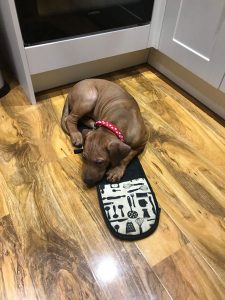
After about 10 days she was responding well inside the house to commands and recalling so we moved outside to the garden.
Moving the training into the garden
We did the same work in the garden and added in doing circles of cones. This really helped in terms of getting her to focus on us, learn how to walk on a lead and in getting the amount of kibble she needed daily into her, as we could reward constantly for her position on lead next to us. She was eating appropriately 900 pieces a day! We practised recall in the garden and it became really good.
One of the really big changes we noticed immediately was the change in her crazy puppy behaviour. Initially, she was really tired of thinking and working out the new rules and slept a lot. It didn’t matter at all that she wasn’t going out for walks. In fact, she was calmer doing the learn to earn. My husband was sceptical at first but within a few days was so impressed he suggested we try the same technique on the kids!
Next step was walking up the lane!
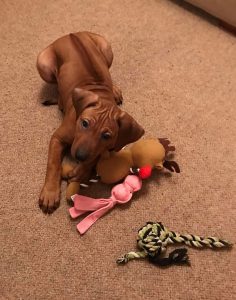
It felt like being back to square one. Red attempted to chase every leaf that blew in the wind, any stone that happened to get kicked and move, pigeons and birds, and rabbits blew her mind! All phenomena she had experienced in the garden and been fine with. She wasn’t remotely interested in the kibble and didn’t seem that aware of me on the end of the leash. After about a week or two of walking up and down the same few yards of lane doing circles and double backing, her leash walking and concentration started to improve. Each time we covered a new piece of ground she would go back a step, but with repetition of the above steps gradually we got further and further. It was a big day when we made it to the field. She finally got the hang of it. To move forward she needed to not pull. Keeping her focus by stopping every so often and practising a sit, or hand touch worked well.
Eventually, when we did let her off lead we practised recall between me and my daughter, again rewarding with food. When the situation arose we were delighted to find that I was able to recall her from a chase after both rabbits and deer!
Rewarding or reinforcing good behaviour with food worked fantastically. At the kid’s meal times, I’d put her in her crate. Each time I walked past if she was lying nice and quietly I’d drop a few bits of kibble into her crate. After just a short time she would voluntarily take herself into her crate when she saw me laying the table. When she later at 10 months old came out of the crate, she still took herself to her bed when we sit at the table to eat. Eating out at pubs and restaurants I would reward her for lying quietly next to me. Very quickly she would just settle down and be no trouble at all.
The learn to earn approach has been invaluable in managing Red through adolescence. In fact, without it, I would have really struggled, as Red has proved to be a very strong-willed female Ridgeback… as Jayne predicted very accurately on the initial home visit. It has allowed me to be more in tune with Red’s mood and level of arousal. I can read her much more accurately. Although this does work both ways! Our bond has been strengthened considerably.
Overall I would highly recommend using this technique for training your puppy.
Garden recall age 6 months. Approx 8 weeks into learn to earn training.
